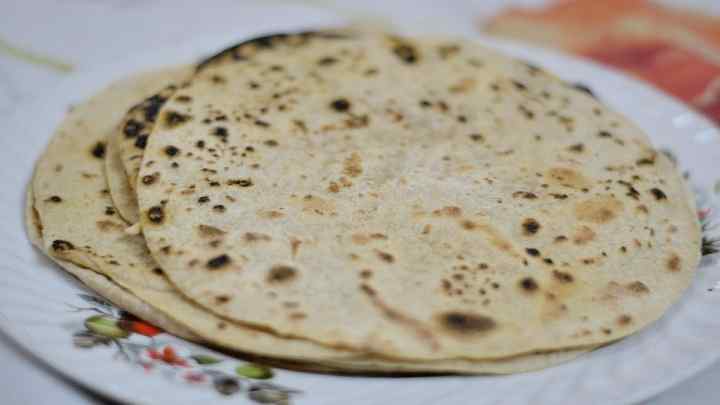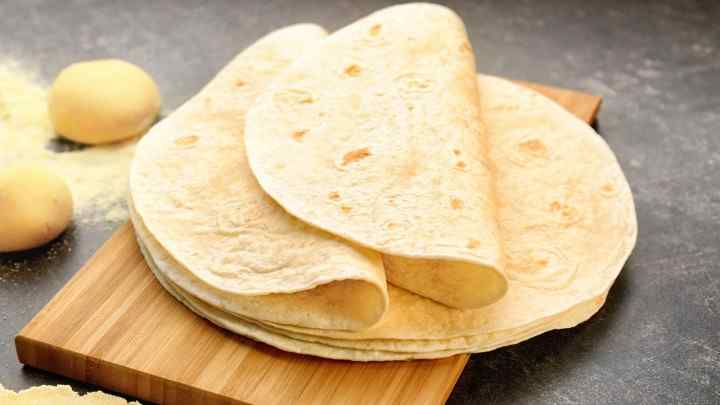Although both are flatbreads made out of flour, roti and tortilla are actually quite different and have varying levels of popularity in their respective regions.
Several variables are involved like the type of flour used, how long it is kneaded, how quickly it is turned out on the skillet, the temperature of the pan, etc.
This article explores the differences between these two flatbreads (roti and tortilla), their health benefits, their uses, and how to make them.
What is Roti?
Native to the Indian subcontinent, Roti is a round flatbread that is made from stone-ground whole wheat flour (gehu ka atta) which is combined with water to form a dough.
Additionally, a distinct characteristic of Roti is that it does not make use of natural leavening agents like yeast.
Also, it is consumed globally, with its popularity being particularly high in countries like; Malaysia, Bangladesh, Indonesia, Nepal, India, Pakistan, Sri Lanka, Thailand, Singapore, Trinidad and Tobago, Mauritius, Fiji, Myanmar, Guyana, Maldives, Suriname, and Jamaica.

Furthermore, like other bread available around the world, roti serves as a staple that goes well with other meals.
Varieties of Roti
Numerous roti variations exist in many cultures across the world from the Indian subcontinent to the Malay Peninsula, Africa, Oceania, and the Americas.
Some of these roti variations include;
Pol Roti or Coconut Roti
Sri Lankan in origin, this variation of roti consists of scraped coconut, wheat flour, and/or kurakkan flour.
Additional ingredients used in cooking the pol roti include onion and chopped green chilis.
Furthermore, their thick texture makes them perfect for eating curry and also come in the form of a main dish rather than sides or appetizers.
SEE: Chipotle Gluten-Free Menu: Enjoy Gluten-Free Mexican Meals
Sada Roti
Popularly made in Trinidad, the Sada roti is made of white flour and is one of the simplest and most consumed rotis in Trinidad.
It is also served with various vegetable dishes and curried meat. The Sada roti serves as a great breakfast option in Trinidad.
Other sada roti varieties include the potato puri, wrap roti, Dhalpuri, puri, and Dosti Roti.
Paratha Roti
This is layered roti that also contains any type of butter but mostly ghee (clarified butter).
Paratha Roti is more flavorful and richer than plain Roti, and can also be enjoyed with a variety of dishes.
Furthermore, like most rotis, the Paratha roti goes well with stews and curries, and can also be eaten with egg dishes, fried eggs, and a cup of tea or beverage.
SEE: Tandoori Roti vs Naan: Their Differences And Uses
What is Tortilla?
Tortilla is a flatbread with a circular and thin appearance that is unleavened and made using wheat flour or maize hominy meal.

These thin flatbreads were first made by Mesoamerican indigenous people before they were colonized.
Their origin dates back to the Aztec period. Furthermore, tortillas remain a key aspect of Mesoamerican food.
Additionally, tortillas exist in varieties, with each variation having a unique ingredient and history that sets it apart.
Wheat Tortilla
Wheat flour tortillas originated in México after wheat was introduced to the American continent.
This variation of the tortilla contains salt, lard, or oil, and also often makes use of baking powder as a leavening agent.
Furthermore, the wheat flour tortilla is commonly used in popular Mexican delicacies like Tacos, Fajitas, and Burritos.
It also remains part of daily meal options in a lot of Mexican homes, with its culture spreading to other American countries including the United States.
SEE: Lola’s Mexican Cuisine: Amazing Foods You Must Try
Nopal Tortillas
Called the cactus-corn tortilla, this is another variation of the tortilla that uses fresh nopales (cactus pads), corn flour, and cilantro. It is also a Mexican staple that is served with numerous Mexican cuisines.
Corn Tortilla
This variety of tortillas is the oldest and comes from masa de maíz, also known as nixtamalized maize.
Corn Tortillas originated in Mexico and have since stayed relevant throughout the American continent.
Additionally, this variety of tortillas dates as far back as the Villa Stage within 1500 to 500 BC and was created by the Oaxaca People in the Mexican region.
What are the Uses of Roti?
Roti is mostly eaten with curries or cooked vegetables, and also mostly serves as a carrier for them.
Also, they are often made using wheat flour and are prepared on a slightly concave or flat iron griddle locally known as Tawa.
You can use Roti to make the following dishes;
- Roti Chiwda
- Sandwich with Roti Cutlets
- Roti Cutlet
- Simple Roti Roll
- Roti Burrito
- Vaghareli Rotli
- Roti Rabdi
What are the Uses of Tortilla?
From Migas Fried Rice to Breakfast Tacos, and Tortilla Chicken Drumsticks, the range of delicious meals you can make with tortillas are quite extensive.
You can also use tortillas to wrap or make the following foods;
- Zucchini Enchiladas with Tomatillo Sauce and Skillet Chicken
- Tortilla Soup
- Shrimp Quesadillas
- Fajitas
- Chicken Pesto Wraps
- Black Bean Burrito with Sweet Potato and Mushrooms
- Spicy Chipotle Chicken Tostadas
- Migas
- Chilaquiles With Fried Eggs
- Breakfast Tacos with Egg, Crispy Potatoes, and Homemade Chorizo
- Tortilla Casserole with Turkey
- Thai Chicken Tortilla Wraps
- Seasoned Flatbread
SEE: Del Taco Breakfast Hours: Start Your Day With Mexican-American Cuisine
What are the Differences Between Roti and Tortilla?
The following help to differentiate roti from tortillas;
Health Benefits
Tortillas: Corn tortillas are rich in magnesium and fiber which is great for heart health and digestion; while magnesium plays a crucial role in strengthening the heart, muscles, and brain.
Both corn and flour tortillas possess the following nutritional profiles;
- Carbohydrate
- Fiber
- Magnesium
- Protein
- Calcium
- Fat
- Sodium
- Iron
- Calories
However, note that the amount of nutrients present in these tortillas differs.
For example, corn tortillas are made of whole grain hence they are richer in fiber when compared to flour tortillas while being lower in calories, fat, and carbs than flour tortillas.
Also, flour tortillas usually contain more fat than corn tortillas because they make use of shortening or lard.
Roti: Plain rotis are rich in soluble fiber which is great in preventing constipation, lowering blood cholesterol levels, aiding proper bowel movement, and keeping the digestive system healthy.
It is also rich in carbohydrates which makes it filling, supplies you with energy, and keeps you satisfied for hours.
Texture
Whole wheat tortillas and roti vary in textures as they make use of different types of fat which adds a level of smoothness to their dough and defines their texture.
While the roti dough which is slightly rougher in texture rarely uses oil, but sometimes uses canola oil or vegetable oil for a smoother texture; whole wheat tortillas use shortening or lard which gives it that smoother and silkier texture.
How Do You Make Roti?
You make roti dough by using a rolling pin to roll out the dough until it forms flat round pieces.
This process usually takes place on a flat board commonly known as a roti board.
Once completed, allow the roti dough to rest for about about 15 minutes before cooking and flipping.
How Do You Make Tortillas?
You can make flour and corn tortillas using the following methods;
Flour Tortillas
To make flour tortillas, start by preheating a non-stick pan to medium heat without the use of oil or butter.
Then place the flattened tortilla dough into the pan for about 30 seconds until you begin to see it puff and turn to a slightly golden color.
Once you see the slightly golden color, turn it over and let it cook for another 30 seconds. Your flour tortillas are ready to eat.
Corn Tortillas
To make corn tortillas, also start by preheating a non-stick pan to medium or high heat, and then place the corn tortilla dough on it to cook for about 10 seconds before flipping it over to cook for 30 seconds.
Flip the tortilla again and allow it to cook for 20 seconds till you see that it’s ready to eat.
SEE: All You Need To Know About Cornstarch Baking Powder
FAQs
Is roti or tortilla vegan friendly?
Roti is vegan-friendly while tortilla isn’t suitable for vegans.
That is because roti does not use animal products like fat or dairy in its, while tortilla makes use of lard (animal fat) or shortening (dairy product) in its dough.
SEE: If Tostitos Tortilla Chips Gluten-Free and Safe to Eat
Can diabetics eat roti or tortilla?
Yes, diabetics can eat both roti and tortilla as they are relatively low in carbs, rich in fiber, and do not contain sugar.
However, roti is much healthier for diabetics as it contains lesser carbs and fat when compared to tortillas.
Which is more healthy between roti and tortilla?
Roti is healthier than tortilla as it contains lesser carbohydrates and fat which makes it great for diabetics or people with heart conditions.
This is because tortillas possess a higher fat count of about 4.5 grams when compared to rotis 2g fat count.
Tortillas also have a higher carbs count of 26g while plain roti has just 18g of carbs.
Conclusion
Ultimately, the differences between tortillas and rotis can boil down to a few key considerations.
Tortillas have more variety and are traditionally used in Mexican cuisine, but this is not necessarily a requirement.
Tortillas are also easier to find, which is a major plus for many consumers.
Roti, on the other hand, boasts more health benefits, especially when it comes to being low in cholesterol and high in calcium.
Finally, whether you prefer the roti or the tortilla, both are great for different types of foods. In the end, each is well worth the try for its unique taste and soft texture.
Do you plan to stock up on tortillas to make delicious Mexican meals? Find out how long it takes for tortillas to go bad before making that move.
I hope you found this article helpful. Thanks for reading.






